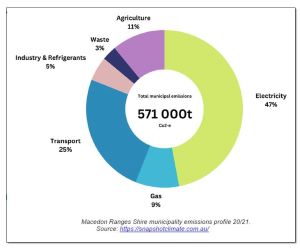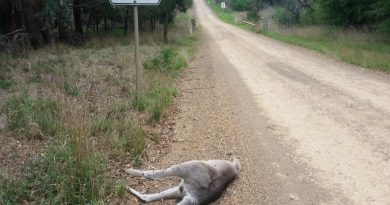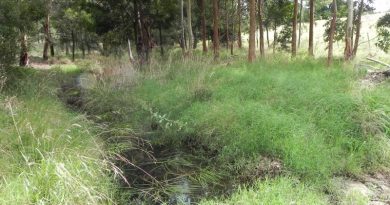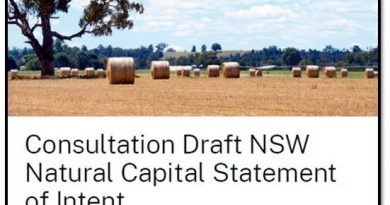A climate emergency plan without targets is greenwashing
By Patrick Francis

In October 2023 the Macedon Ranges Shire Council requested submissions about its Draft Climate Emergency Plan 2023 – 2030. It my view the Plan fails to identify actual greenhouse gas emissions reductions from what were generated shire wide in 2021. With no emission reduction or carbon abatement targets included such as 50% emissions reduction by 2030 as recommended by the Intergovernmental Panel on Climate Change (IPCC) it fails as a plan to address climate change and contribute to limiting global warming to 1.5C.
The submission
The Macedon Ranges Shire Council’s Draft Climate Emergency Plan 2023 to 2030 is best described as a wish list of good ideas for adaptation to Climate Change by Council and the wider community. It fails to deliver the key requirement of an effective action plan for the Climate Emergency, targets for reduced emissions across its own activities and the community’s activities. The lack of any targets means the Plan fails the United Nations test for tackling the Climate Emergency and may even be considered a greenwashing plan.
In 2022 the UN Secretary General António Guterres said “We urgently need every business, investor, city, state and region to walk the talk on their net zero promises. We cannot afford slow movers, fake movers or any form of greenwashing.”
Furthermore in its 2022 Report “Credibility and Accountability of Net-Zero Emissions Commitments of Non-State Entities” the United Nations chair of the High level Expert Group Catherine McKenna states “Though countries need to take the lead, solving the climate crisis is not up to them alone. Non-state actors— industry, financial institutions, cities and regions —play a critical role in getting the world to net zero CO2 emissions no later than 2050. They will either help scale the ambition and action we need to ensure a sustainable planet or else they strongly increase the likelihood of failure. The planet cannot afford delays, excuses, or more greenwashing.
“We know what we need to do: peak global emissions in just three years, by 2025, and cut emissions in half in less than eight years, by 2030. Non-state actors cannot focus on reducing the intensity of their emissions rather than their absolute emissions or tackling only a part of their emissions rather than their full value chain (scopes 1, 2 and 3 emissions).
By McKenna’s description the MRSC Draft Climate Emergency Plan fails by its own Climate Emergency definition on page 4 which fails to include any reference to reducing emissions by any amount by 2030 and there are no emissions reduction targets across the shire’s scope 1, 2 and 3 emissions. Total shire 2021 emissions profile is shown in Figure 1 on page 5 and totals 571,000 tonnes across six sectors.
Once a government makes a Climate Emergency declaration, the next step is to set priorities to mitigate climate change. This means taking action to limit climate change by reducing emissions of greenhouse gases or removing those gases from the atmosphere (abatement). The Council’s Draft Strategy definition doesn’t deliver any targets for reducing emissions or for removing greenhouse gases from the atmosphere (abatement).
The Credibility and Accountability of Net-Zero Emissions Commitments of Non-State Entities report contends that targets are the cornerstone of effective climate emergency action.
“A net zero pledge must contain stepping stone targets for every five years, and set out concrete ways to reach net zero in line with the Intergovernmental Panel on Climate Change (IPCC) or International Energy Agency (IEA) net zero greenhouse gas (GHG) emissions modelled pathways that limit warming to 1.5°C with no or limited overshoot. The plan must cover the entire value chain of a city, state or business, including end-use emissions. It needs to start fast and not delay action to the last minute, reflecting the fact that global emissions must decline by 50% by 2030 (page 12).
“A net zero pledge should be made publicly by the leadership of the non-state actor and represent a fair share of the needed global climate mitigation effort. It should include an assessment of existing conditions including baseline emissions, regular greenhouse gas inventories, a long-term emissions trajectory, accountability measures, climate risks and socioeconomic priorities.”
The MRSC Draft Climate Emergency Plan 2023 – 2030 contains just one of the requirements mentioned above – the baseline emissions figure 1 on page 5. Thereafter, numbers around emissions and interim target do not exist. In fact the words “net zero emissions” appear in the document twice, once in regard to Council’s own operations and services (page 7) and once in regard to community emissions but no data is provided around either.
The Plan authors know that scope 1, 2, and 3 greenhouse gas emissions across the shire are planned to increase due to:
* Population and transport increase
* Household construction increase
* Infrastructure construction increase
* Service provision
* Waste treatment.
By how much these increases will be offset by advances in renewable energy generation, battery storage, eliminating gas, electric vehicles, reafforestation on farm land etc is unknown as the Strategy’s authors provide no data.
By making claims around reducing emissions through Council’s actions and through Community actions without data to substantiate the amounts, then the draft Plan could be considered a greenwashing exercise.
Evidence for making this conclusion comes from the most obvious and easily calculated sources of increased greenhouse gas emissions, in particular the Council’s stated population and households increase to 2036, figure 1. Household are responsible for around 20% of the nation’s greenhouse gas emissions with each household currently producing 15 to 18 tonne CO2e per year. With an extra 6000 household across the shire, the annual increase in emissions from this sector will be 90,000 to 108,000 tonne CO2e per year based on business as usual. Emissions per household, particularly new builds, will be reduced to some extent by increased use of renewable electricity, climate aware house design and insulation but are not anticipated to be decreased by more than 50% by 2050.
Household emissions are reflected in the Shire’s total emissions profile across the electricity, gas, transport, and waste sectors, see figure 3B. No attempt has been made to provide data around the impact of increasing number of households on the Shire’s emissions profile in 2030 and every five years after that up to 2050.

Figure 1: The number of new households across the shire are anticipated to increase by around 6000 by 2036.
Associated with new household construction is a significant increase in infrastructure emissions to build homes especially on greenfield sites which is being advocated by Council rather than within existing town boundaries (see the 2023 Draft Romsey Structure Plan as an example where 394 hectare of farm land are proposed for housing and industrial development, Figure 2A).
Potential exists for increasing housing density within town boundaries rather than building on greenfields sites and subsequently reducing infrastructure build emissions and even household emissions themselves in smaller houses requiring less energy for heating and cooling, figure 2B. But there are no figures or target dates included within the Draft Plan for such emission reduction possibilities.

Figure 2A: New housing on greenfield sites is a major source of greenhouse gas emission via machinery for earthworks for sewer, power roads, materials for roads, as well as building construction. Photo: Patrick Francis, Romsey 2023.
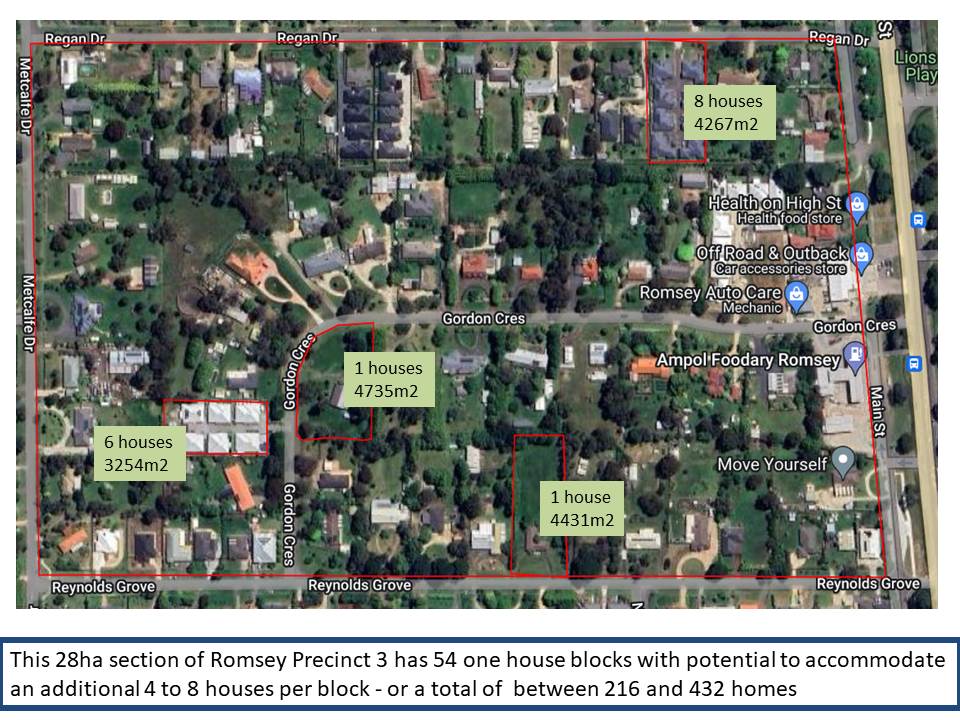
Figure 2B: The United Nations is advocating for towns and regions to implement higher density housing within town boundaries as a way of reducing housing emissions and retain undeveloped land for nature and biodiversity preservation plus and carbon sequestration .Sources: Image Google, data Patrick Francis.
The plans for new housing estates across the shire on greenfield sites like the 394ha associated with the proposed extended town boundary around Romsey contravenes the advice from the United Nations around credible net zero emissions strategies. It states “Cities and regions should look to promote compact, dense development that is better able to protect existing nature and build up new and additional natural systems. Examples include: adding transit-oriented (not car-oriented) development, avoiding greenfield development, retrofitting old buildings/infrastructure (instead of building new), and establishing protection areas around water resources like wetlands, streams, reservoirs and coastal ecosystems. These actions can serve not only to preserve nature and ecosystems but also to provide climate adaptation and resilience, as well as equity benefits, in urban settings”.
Future annual household emissions, construction emissions and waste collection and treatment omissions are not accounted for in the draft Plan. Despite Council having an agenda for population and housing increase up to 2036 there is no emissions data presented around its impacts on the shire’s ability to be carbon neutral and achieve net zero emissions by 2050.
Another important emission contributor with no targets in the draft Plan is emissions from vehicles. While the Council presents a target for conversion of its own fleet vehicles to electric there is no target for community electric vehicles despite the fact that numbers of vehicle per household are increasing.

Figure 3A: Household greenhouse gas emissions are dominated by transport and this component is likely to increase as the Shire’s population increases for travel within towns as well as outside towns for work and recreation.
The issue of vehicle emissions in the Shire is particularly important as there is a phenomenon happening around car ownership which is unusual for the state. The number of households with three cars in increasing at a rate higher than the state average, figure 3B. The number of people per household is not increasing and is predicted to remain constant at 2.6 persons per household until 2036.
The Draft Strategy has no target for percentage of vehicles owned by households which will be electric by 2025, 2030 and 2036. Nor does it have any target dates for installation of electric vehicle charging stations – referring only to “facilitating the installation of five public electric vehicle charging stations” (page 7) across the shire. This is a greenwash statement as the proposal is not supported by data about when and where these will be installed and the number is highly inadequate for such a large rural shire with most residents travelling by private vehicle to work.
Figure 3B suggest that in 2021there were more than 36,000 vehicles in households across the shire, yet the Draft Plan presents no data on what percentage is already electric and targets for increasing electric vehicle ownership.

Figure 3B: In 2016 26.8% of Shire households had three vehicles, in 2021 this figure had increased to 29.1%. Source: MRSC
Another vehicle emissions omission in the Draft Strategy is the Council’s own Scope 1 and 3 vehicle omissions. Council has its own road maintenance heavy vehicles such as tractors, graders, compacters, to maintain approximately 1700 kms of rural roads across the shire. The emissions from these vehicles in not accounted for in the Draft Strategy. They may not even be accounted for in Council’s net zero emission by 2030 target?
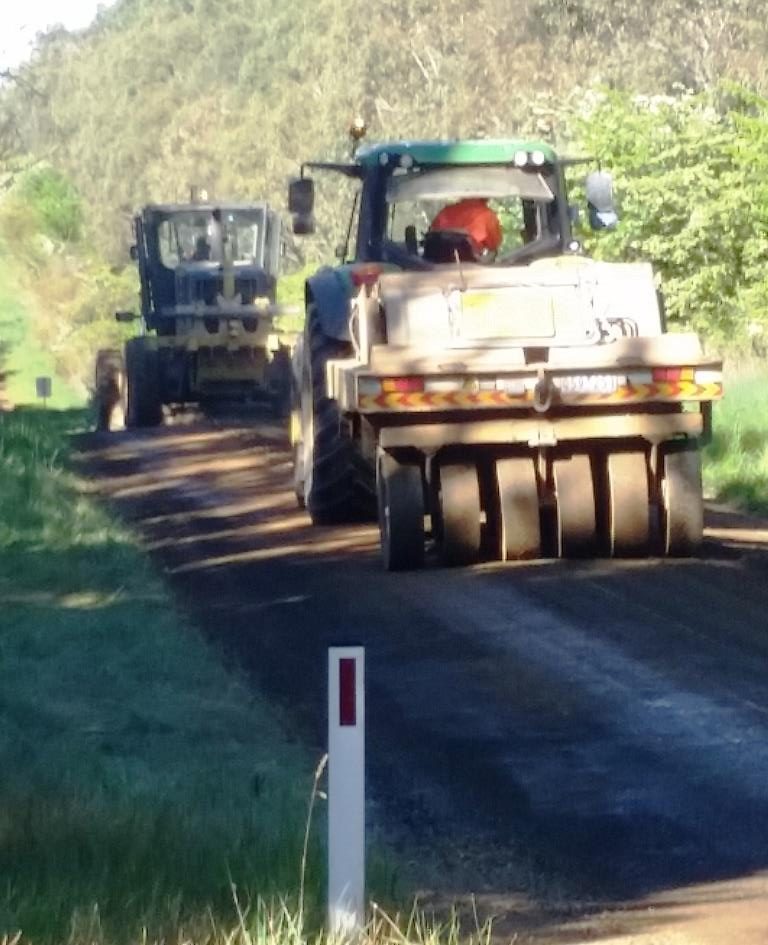
Figure 4: Council’s road maintenance vehicles are an important source of greenhouse gas emissions but their contribution is not accounted for in the Draft Climate Emergency Strategy. Photo: Patrick Francis.
Nor are the Scope 3 emissions generated by vehicles used be contractors to supply council services in particular the kerb side collection recycling trucks and the verge and park mowing and slashing vehicles. It is sometimes argued that Scope 3 emissions not to be accounted for but Local Government NSW states in “Undertaking and Interpreting greenhouse gas inventories” that common Scope 3 emissions that should be accounted for are “outsourced waste disposal (i.e. employing waste contractors/delivering waste to non-Council waste management facilities) and outsourced services to manage park, garden, roadside verges (lawn mowing and slashing) contractors.
Failure to recognise these important emission sources within the Draft Plan and the Council’s own net zero emission 2030 targets suggests it is not a serious attempt to counter the Climate Emergency with genuine emissions reduction strategies and targets.
Across the entire Draft Plan there is no attempt to quantify how its strategies are going to impact the Shire’s emissions profile quantified as 571,000 tonnes in 2021 as demonstrated on page 5 of the Draft Strategy, figure 5A. The actual emissions contributed from each sector as quantified for the Shire is shown in figure 5B
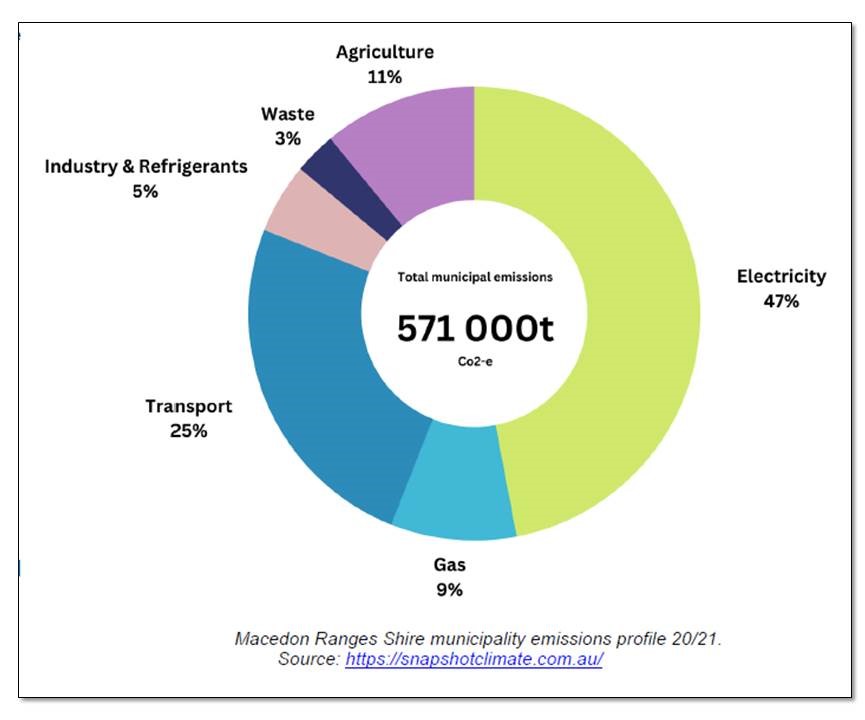
Figure 5A: The Macedon Ranges Shire 2021 emissions profile is dominated by electricity and transport emissions. Source: Snapshot.
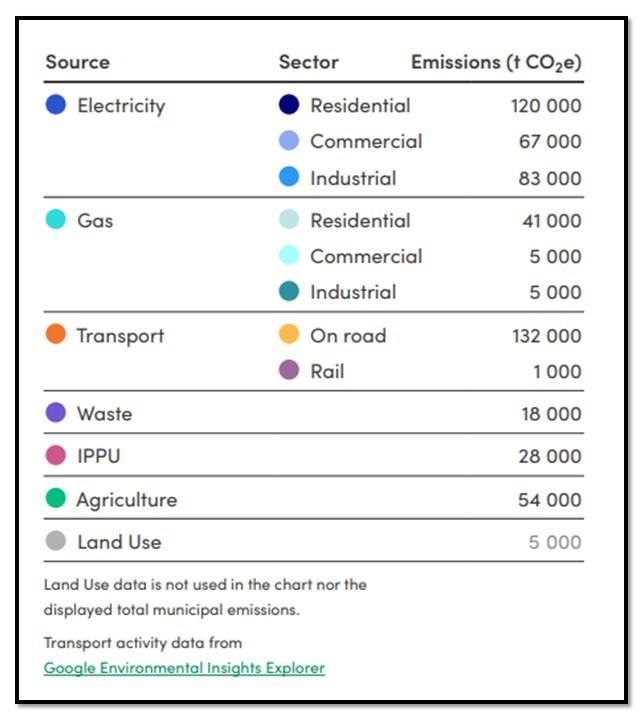
Figure 5B: Macedon Ranges shire 2020 sector emissions quantified. Source: Snapshot.
The Draft Strategy’s approach to the emissions generated by each sector is to mostly provide greenwash statements that provide no direction future emissions will take outside of the Shire’s own area of responsibility and even then some of its scope 1 and scope 3 emissions are ignored.
Agriculture:
No target mentioned for reducing its emissions. This is despite the Shire having 85,000ha of farming zone land and 47,000ha of rural conservation zone land, all of which has considerable potential to sequester carbon and achieve carbon neutral status over the next 20 years with reafforestation. There is also potential for many of the farm to sell reafforestation carbon credits via the Emission Reduction Fund to organisations like Councils who may require them to meet net zero status by 2050.
If 10% of land in these two agriculture zones was replanted with forest species there is potential given the Shire’s moderate to high rainfall and good quality soil to sequester around 132,000 tonnes of CO2e per year for at least 30 years. This would mean the agriculture sector becomes a net carbon sink to the tune of around 80,000 tonnes CO2 per year.
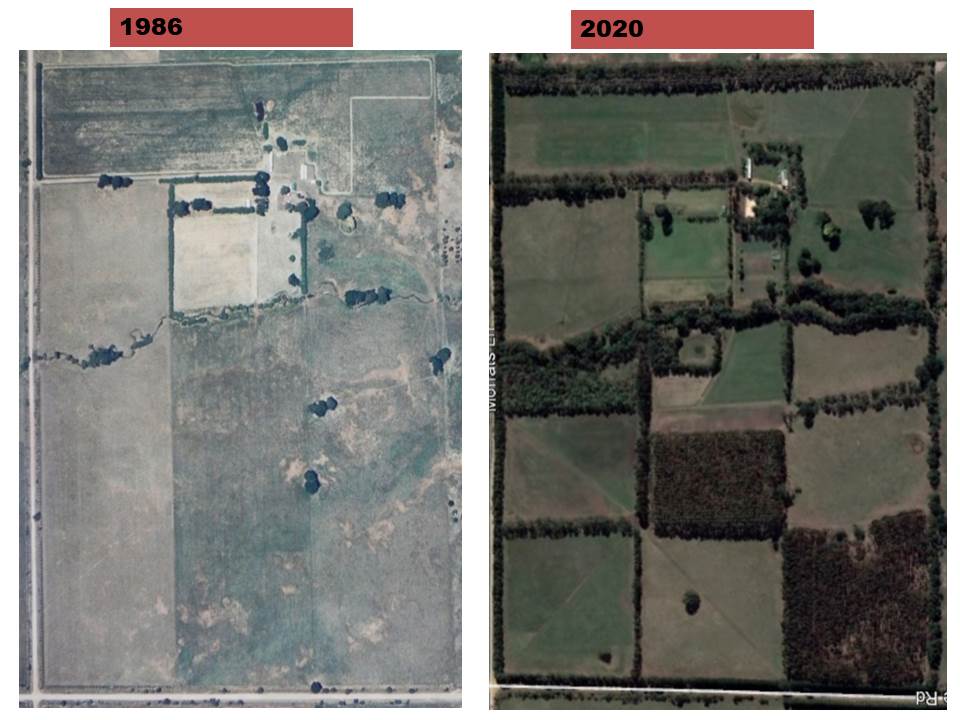
Figure 6: Macedon Ranges Shire farms have enormous potential to be net greenhouse gas sinks with reafforestation. This farm close to Romsey is net carbon sink to the tune of around 200 tonnes CO2e per year as a result of revegetation of 23% of pasture land with native forestry species. Source: Google.
Despite reafforestation’s enormous potential for carbon sequestration and biodiversity enhancement the Draft Strategy’s authors show little interest in promoting it as a significant and practical source of offsetting stating on page 12 under “Our Climate Emergency priorities” that “Actions such as offsetting projects will be vital into the future but are not the golden ticket out of the Climate Crisis”. This statement is at odds with the UN recommendation “We know what we need to do: peak global emissions in just three years, by 2025, and cut emissions in half in less than eight years, by 2030”. In other words delaying action to prevent global warming is not an option. A climate emergency strategy needs to start fast and not delay action to the last minute, reflecting the fact that global emissions must decline by 50% by 2030.
The Draft Strategy has no 2030 target for the Shire’s emissions in 2030 let alone a 50% reduction.
The Draft Strategy’s attitude towards reafforestation is also at odds with the Federal government’s Clean Energy Regulator which put considerable emphasis on reafforestation methods to generate carbon credits which companies and government can purchase to offset emissions.
“A reforestation and afforestation project involves planting forest trees in agricultural areas. In doing so, the project helps to reduce the amount of greenhouse gas entering the atmosphere, as carbon remains stored in the trees while they grow (referred to as ‘carbon stock’). Net reduction in greenhouse gas emissions as a result of a project is referred to as ‘net abatement’.”
Vegetation methods are the most popular method of generating Australian Carbon Credit Units. During the 2022 – 23 year 15.7 million ACCUs were issued, of which 52 per cent were from vegetation projects, figure 7. One ACCU represents 1 tonne of CO2 equivalent.

Figure 7: Vegetation methods on agricultural land which includes reafforestation are the most used way of generating Australian Carbon Credit Units but are ignored in Shire’s Draft Climate Emergency Strategy. Source: Clean Energy Regulator 2022 – 23 Annual Report.
The Draft Strategy mentions Carbon Sequestration Projects in its NN4 Action on page 17 but these reflect a greenwashing approach with no actual targets for carbon abatement on a per hectare basis via reafforestation. For instance in 4.2 it refers to “investigate the availability of Council-owned land to provide sites for offsets. Authors know the area of council-owned land in the shire and could have provided an indicator of carbon abatement per hectare per year on a percentage of that area if reafforestation was undertaken.
In 4.1 it refers to “Continue to develop a Local Community Carbon Offsets Program” which suggest carbon offsets are happening but there is no data provided about the amount of carbon abatement achieved or any targets for future abatement between 2023 and 2030. Without data such a statement is greenwashing.
There are statements in the Draft Strategy which suggest that the authors have little understanding of how agriculture’s emissions are generated or reduced. Under “Our climate emergency priorities” on page 12 it refers to “reducing fertiliser use on farms” and “regenerative farming practices …produce low levels of carbon”, both statements are misleading.
Without fertiliser pasture and crop production will decline as soil health declines due to mining of nutrients through exports of food off farm. Nutrients are important for healthy plant growth and across the ruminant livestock sector which dominates farming in Macedon Ranges Shire, reducing use of fertiliser will lower pasture production, encourage less palatable species like bent grass and slow growth rates of sheep and cattle which in turn increases their methane emissions per kilogram of carcase weight sold.
The statement “regenerative agriculture practices …produce low levels of carbon” must be an error as farming best practice relies on increasing and maintaining the highest possible levels of carbon within soil, within pasture and crop plants and within remanent and replanted vegetation. The authors most likely mean “ …produce low levels of carbon emissions”. Regenerative agriculture practices are not of themselves a recipe for reduced carbon emissions, what impacts emissions is how key contributors are managed. With ruminant livestock methane emissions can be lowered per kg of carcase weight sold by genetic selection for faster growth rate, by selection for higher fertility, by planting high digestible and palatable pasture species that optimise animal growth rate, by ensuring pasture plant health is optimised via provision of adequate soil nutrients, soil pH and grazing interval and by matching paddock stocking rate to paddock carrying capacity. These are all components of a suite of best practice livestock management strategies that reduce emissions of methane per kg of carcase weight sold and are not confined to a particular farming methodology.
Draft Plan’s themes and proposed actions
Nurturing Nature
The Nurturing Nature (NN) Actions are mostly about supporting the community to adapt to climate change rather than reducing emissions or producing greenhouse gas abatement. It refers to community education, protecting remnant vegetation, increasing urban biodiversity, river creeks and waterway care, integrated water management, future proof plantings, continue implementation of the Biodiversity Strategy and adaptive pest plants and animals planning. These are all part of best practice environmental management but are not strategies that will counter the climate emergency by reducing emissions and abate greenhouse gases in a significant way as is being advocated by the United Nations and the IPCC.
The Carbon Sequestration Projects actions in this theme are positive ideas for emissions abatement but are so poorly researched offer no direction for action. See discussion above which demonstrates that reafforestation across the shire’s farming and rural conservation zones could sequester around 132,000 tonnes of CO2e per year for at least 30 years. Why was this level of investigation ignored by the authors?
Climate-ready Communities
The same applies to the Climate Ready Communities (CRC) theme and actions, all are positive action for best practice environment management and adaption to climate change. But as presented will not counter the climate emergency unless significant reductions in emissions are achieved and real greenhouse gas abatement is generated. So the CRC Actions for Healthy Landscapes, Business energy support, Regenerative Farmers Action Group, Resource Smart Schools , Water Sensitive and Urban Design, Home Water Literacy Education, Urban Cooling, Community Food Security, and Connecting with Local Farmers are all climate change adaptation strategies not climate emergency threat reduction strategies.
The CRC strategies which can impact climate change by reducing emissions are Business Energy Support, Expand Council Sustainable Buildings Policy and Practice, Household energy efficiency, Equitable Household Transition, Climate Ready Housing and Climate Action grant and support. But the authors fail to provide any data on extent of adoption uptake on reducing current emissions (figure 5A and 5B) or any target dates.
Post Fossil Fuels
The Post Fossil Fuels (PFF) theme and actions is the most positive for reducing emissions but its lack of data and five year targets means the suggested actions have no credibility for achieving any outcomes.
For instance the Support Electric Vehicle uptake action should contain data on percentage of current community vehicles that are electric and target for that percentage in 2030 and what that would mean to lowering the shire’s transport emissions as per figure 5A and 5B.
The same applies to the Pathway to renewable energy for community groups’ action, it lacks any targets for installation of a solar farm or community batteries to store roof top solar. It is also bizarre to suggest “explore the possibility of establishing a small-scale solar farm on a closed landfill site within the shire” when towns like Romsey, Lancefield, Riddles Creek are surrounded by developer owned farming zone land adjacent to town boundaries that is suitable for solar farms. A serious climate emergency strategy would include a solar farm and battery situated alongside each town in the shire where land is available and have dates planned for installation.
The Uptake and engagement in active transport action can hardly be taken seriously when Council is supporting housing development of greenfields sites outside town boundaries which are so far away from services that walking and cycling will be most ignored by residents in favour of using cars.
These two examples reek of greenwashing.
Health & Wellbeing
The Health & Wellbeing (H&W) theme and actions are all about adapting to climate change rather than reducing emissions or greenhouse gas abatement. This is demonstrated in Veg Action Group, Amplify benefits of participation, Youth Action Support, Extreme Weather Support, Sustainable sports, and Mental Health support. They are all positive actions but don’t help avert the Climate Emergency.
The Health & Wellbeing theme’s community vision is partly misleading when it states “our lifestyles are more active and we are inclusive and community minded ….and people feel safe and more connected to nature”. This is not the case for residents who like to exercise on local roads through natural habitat outside of town boundaries. Many of these roads are dangerous to use because the Council has not acted to reduce the default speed limit from 100km/hr to a much safer 40 – 50km/hr. As a result many residents especially those with any disability cannot use these minor rural roads to connect with nature and for exercise.
Waste & Circular Economy
The Waste & Circular Economy (W&CE) theme and actions is mostly about environmental management best practice with little impact on emissions reduction or greenhouse gas abatement. Waste represents approximately 3% of the Shire’s emissions.
Adaptation & Emergency Response
There is some irony in the authors including Adaption & Emergency Response (A & ER) as a separate theme when most of the themes contain multiple actions which are about adaptation to climate change and the climate emergency rather than reducing emissions or greenhouse gas abatement to prevent global warming increasing above 1.5C.
Monitoring and Evaluation
As for the last section Monitoring and Evaluation in relation to reducing the Shire’s emissions as per figure 5A there is no data to demonstrate monitoring is taking place to achieve the objective of reducing emissions or abating emissions on target dates as suggested by the UN’s Integrity Panel of experts to achieve a 50% reduction in emissions by 2030 and net zero by 2050 hence avert the climate emergency.
Summary
The Draft Climate Emergency Plan 2023 – 2030 lacks credibility as a blue print for action to address the Climate Emergency facing the world as its ignores putting in place any emissions and abatement targets up to 2030 and beyond which show by how much the shire’s emissions across six sectors will be reduced from the 2021 total of 571,000 tonnes CO2e
Earlier in 2023 the United Nations Secretary General called on non-State entities to put forward credible and transparent transition plans and to submit them before the end of this year.
“Since the adoption of the Paris Agreement in 2015, the world has seen an increasing number of net-zero commitments by non-State actors, in particular from the private and financial sectors, as well as from local government and regions. The growth in pledges has been accompanied by a proliferation of criteria and benchmarks to set net-zero commitments with varying levels of robustness. This misleads consumers, investors, and regulators with false narratives, and it feeds a culture of climate misinformation and confusion.” This statement seems to reflect what the Draft Climate Emergency Plan 2023 – 2030 offers.
Interesting the Plan states on page 5 under the heading Our Climate Journey that the United Nations and IPPC “… has advised we are at a crossroad. … This “crossroads” offers us the opportunity to look ahead, mobilise, and, importantly, participate in the solutions that will bring a safer, healthier and more resilient Macedon Ranges.” The Plan has failed to provide the shire with a realistic path forward to counter the climate emergency to stay below 1.5 °C of global warming, by cutting its 571,000tonnes CO2e emissions roughly 50% by 2030.
References:
high-levelexpertgroupupdate7.pdf (un.org)
Drivers of population change | Macedon Ranges Shire | Population forecast (id.com.au)
Microsoft Word – CCWP Module 5 – Undertaking and interpreting GHG inventories.docx (lgnsw.org.au) Module 5 – Undertaking and Interpreting Greenhouse Gas Inventories
Reforestation and afforestation (cleanenergyregulator.gov.au)
Appendix
An indication of the Draft Climate Emergency Plan authors understanding of issues associated with global warming and climate change is the number of times the document includes references to particular organisations and topics. Here is list of relevant topic headings and the number of times they were referred to in the document.
Clean Energy Regulator 0
Emissions Reduction Fund 0
IPPC 2
United Nations 1
Reafforestation 0
Soil carbon 0
CO2 3
Methane 1
Australian Carbon Credit Units 0
COP18 0
COP 17 0
Safeguard mechanism 0
Carbon abatement 0
Carbon sequestration 1
Net zero emissions 2
Emissions targets 0
Scope 1 2 3 emissions 0
Household emissions 0
Vehicle emissions 0
Industry emissions 0
Greenhouse gas emissions 1
Solar battery storage 0
Solar panels 1
Renewable energy 21
Population increase 0
Vehicles increase 0
Climate action 25
Fossil fuels 6

